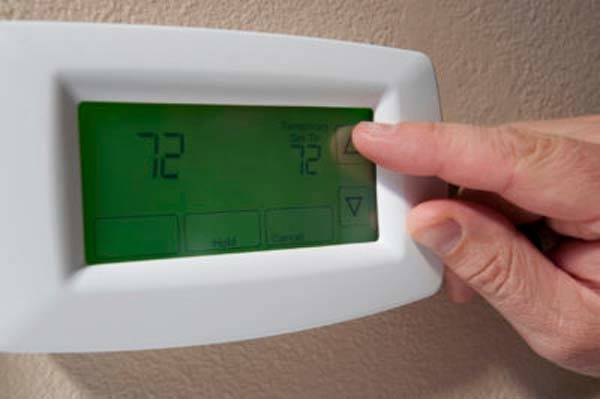Why Is My AC Blowing Hot Air? A New Mexico Tech Answers

So you’ve noticed that your air conditioner is blowing not-so-cool air. In fact, the air you feel coming from your vents is warm, or even hot.
We know—it’s not an ideal situation to find yourself in so we’ll do our best to help you through it.
To start, let’s explore the most common reasons an AC blows hot/warm air:
- Your thermostat settings are incorrect
- There’s an issue with your outside unit
- Your system has a refrigerant leak
- Your evaporator coil is dirty
Of course, that’s not an exhaustive list of all the possible issues but they’re the most common culprits of an AC that’s not blowing cold air.
We’ll run through each possible issue in more detail below. We’ll explain what you can do on your own to try and solve the issue vs. what will require a professional repair.
Need a professional repair right away? Just call TLC. One of our licensed and skilled AC repair techs will head over in a fully-stocked truck to diagnose and repair your AC system in no time.
Possible issue #1: Incorrect thermostat settings
First, head to your thermostat to make sure that:
- The thermostat is set to COOL
- The fan setting is set to AUTO
We know it sounds obvious but we get a lot of homeowners who call us out for a professional repair when they simply needed to adjust their thermostat from HEAT to COOL. Additionally, some homeowners mistakenly keep their fan set to ON instead of AUTO (we’ll explain why this matters below).
A quick explanation on why your fan should be set to AUTO:
If your fan is set to ON, it means you’ve set your AC blower fan (located in the indoor unit) to blow non-stop, even when the AC isn’t actually cooling your air. That means that in between cooling cycles, the blower fan will continue to blow air into your home but that air won’t be cooled and humidified, instead it will be warm.
When your fan is set to AUTO, however, it means the fan will only blow when the AC is actively cooling the air (which means it will only blow cold air).

Possible issue #2: There’s an issue with your outside unit
Your outside unit is responsible for dumping all the heat from inside your home into the outside air. But if the outside unit isn’t operating properly, it could end up sending that heat right back inside where it will be blown through your home’s vents.
Before we get into the issues that might be wrong with your outside unit, try these troubleshooting tips:
- Inspect your outside unit.
- Remove any leaves, twigs, dirt or debris from the surface/sides of the unit
- Gently spray the outside unit fins with water to remove any dirt. If the unit is particularly dirty, try cleaning the fins with a coil cleaner.
- Make sure the unit has at least 2 feet of “breathing room” on all sides (i.e. clear away any foliage or growth within 2 ft)
- After completing steps 1-4, check to see if your AC is blowing cold air.
If your AC is still blowing warm air, you will likely need to call a professional to diagnose your AC and fix the problem.
Some possible outdoor unit issues that can cause the AC to blow warm air include:
- Your compressor needs to be replaced. Your compressor is a device that sits inside the outdoor unit. Its job is to pump refrigerant throughout the AC system. If the compressor is old or faulty, it can’t circulate the refrigerant properly, which will cause the AC to eventually lose cooling capacity and blow warm air. Unfortunately, the compressor is an expensive part to replace so make sure to check whether the compressor will be covered by the AC parts warranty. If it’s not, you may want to consider replacing the entire AC unit vs just replacing the compressor.
- The refrigerant metering device is jammed. If the refrigerant metering device is jammed, the same issue as above will occur—refrigerant won’t circulate through the system properly, which will cause the AC to lose cooling power and blow warm air. If this is your issue, a professional HVAC tech will need to fix/unjam the device.
Possible issue #3: Your system has a refrigerant leak
Refrigerant is the life blood of your AC system; it’s a heat-transfer chemical that runs through the entire AC system and is responsible for absorbing heat from the air inside your home.
If refrigerant is leaking out of your AC system, though, your AC will lose its ability to absorb heat. That means that eventually, the air coming from your vents will be warmer and warmer as more and more refrigerant is lost.
Signs that indicate your “warm air” issue is due to a refrigerant leak:
- A hissing noise coming from your AC system
- Ice on the AC refrigerant lines and/or a frozen evaporator coil
- Water pooling around your indoor AC unit
- Higher-than-normal energy bills
If you think you have a refrigerant leak, you’ll need to have a professional find the leak, repair it and then recharge the system.
Heads up: If your AC system uses an older refrigerant like R22, you may want to replace your entire AC system vs paying an arm and a leg to recharge the system.
Learn more about R22 and why it’s so expensive in our blog, “Older Air Conditioner? R22 Refrigerant Phase-Out Information”.
Possible issue #4: Your evaporator coil is dirty
Your AC’s evaporator coil sits inside the indoor air handler unit (see image below). The evaporator coil is composed of many copper coils, all of which are filled with cold refrigerant. The job of the evaporator coil is to absorb heat and moisture from air that passes over the coils.

If the evaporator coil is dirty, though, the dirt acts as a barrier between the warm air and the cold refrigerant. When there’s a dirt barrier, the refrigerant can’t absorb enough heat, which means that the air blowing from your vents will be warmer than usual.
Over time, dirt on the coils can cause the evaporator coil to ice over and eventually freeze into a solid block of ice, which can lead to more expensive damage. That said, if your evaporator coils are dirty, you’ll want a professional to clean them ASAP.
Need a professional to diagnose and fix your AC issue?
Just call TLC’s team of experienced AC repair techs. We have over 30 years of experience repairing ACs throughout the New Mexico area, including Albuquerque, Santa Fe and the surrounding areas. Our techs are ready 24/7 to handle any AC issue you may have.
